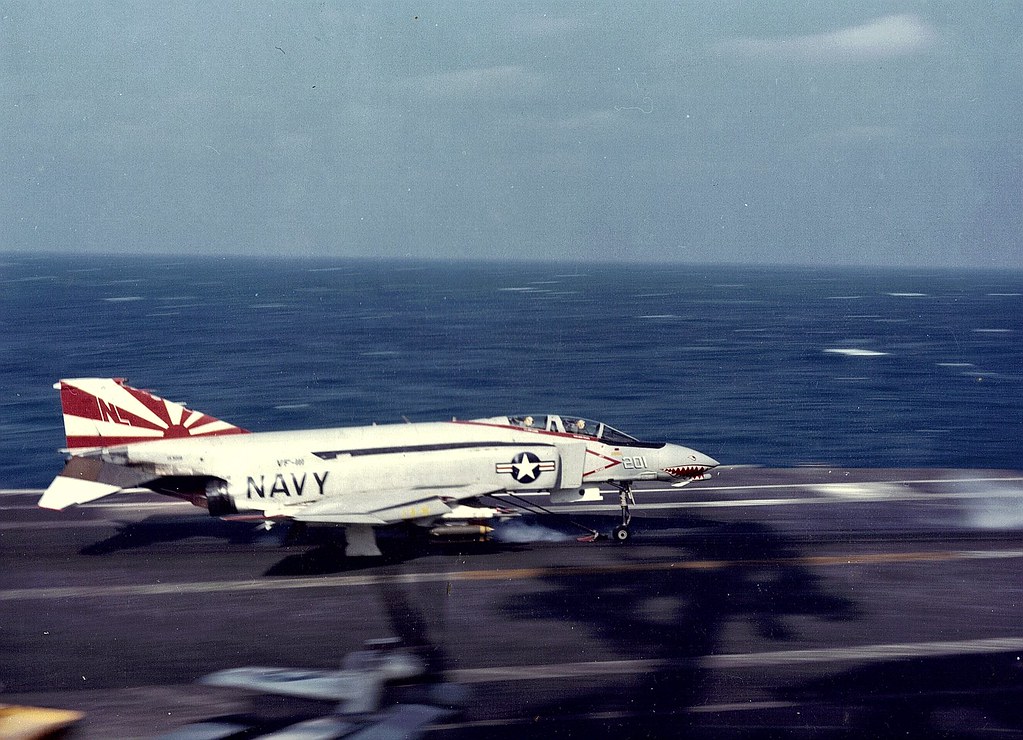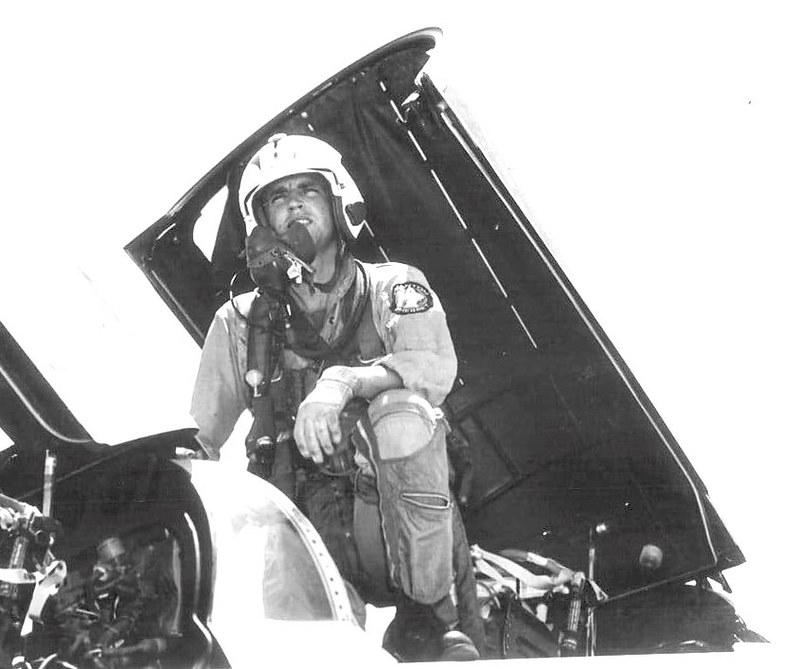
Peter Greengrass
-
Posts
37 -
Joined
-
Last visited
Content Type
Profiles
Forums
Events
Posts posted by Peter Greengrass
-
-
This rather interesting photo was posted to FB by Brian Kincaid (taken by his father Gary Kincaid, a VF-114 pilot) of a VF-114 F-4J with LGBs. Even though I was previously aware that both VF-114 & VF-213 had dropped both Mk 82 & Mk 83 LGBs (Pave Way I/IIs ?) during their 1972 Vietnam cruise (VF-213 claiming in their 1972 Command History Report that they were "the first Navy F-4 squadron to deliver the laser guided bomb against enemy positions" in June 72) this is, as far as I recall, the first time I've seen a photo of one toting them.

- Finn, thierry laurent, alain11 and 2 others
-
 5
5
-
- Jim Mason, Marcel111, easixpedro and 2 others
-
 5
5
-
- easixpedro, firefly7, Jim Mason and 1 other
-
 4
4
-
Well, there are many variables but taking some numbers from the F-4B NATOPS, F-4B Standard Aircraft Characteristics, F-4B/J Plane Captains Handbook and a McAir Ordnance booklet....
Basic weight 28265 LBS
Internal Fuel 13729 LBS
C/L Tank Fuel 4094 LBS
AIM-9D 186.8 LBS x 4= 46,835.2 Pounds
An Empty C/L tank was 235 LBS (didn't include that above) whilst a Wing Missile Pylon was 146 LBS (though not sure if these would be included in the basic weight). AIM-7E Sparrows were 434.5 LBS each.
However, a quick browse through some images would suggest that they didn't always write these all in, many times just the total weight...and sometimes nothing at all...
HTH
Pete -
- Anthony in NZ, easixpedro and Martinnfb
-
 2
2
-
 1
1
-
6 hours ago, Joe Hegedus said:
Weren't rockets removed from US Carriers following the Forrestal fire in '68?
The fire was in 1967, but I suspect this is one of those "myths"
VF-102 F-4J aboard America during their 1968 cruise and airborne, off the Independence, in the Med in 1973 with rocket pods. Also attached is a snippet from CVW-14/Constellation 1968-69 cruise report, showing that Zunis (LAU-10s) were still very much available for upload. -
-
-
37 minutes ago, Finn said:
Interesting concept, not to hijack the thread but Peter do you have any info on the pod that was on A-7s during the war:
I'm very much an F-4 and F-4 only guy, so I'm not going to be very useful! I did have a browse thru CVW-14s Cruise Report for 1968-69 and the only thing that I can't find anything on is the North American NAMAR photo pod that was used by the A-7As in that air wing. Googling that turns up zero hits. Of course, that might not even be that.
-
For those looking for something different and somewhat unique for their Navy F-4Bs, and noting the discussion of USAF MER/TERs, I thought the following might be of interest to some.
During CVW-9/USS Enterprise’s November 1966 to July 1967 combat cruise, the only means of obtaining combat photography available to the F-4Bs of VF-92 and VF-96 was the PMR/AFH-15 Camera Pod (developed by VX-4 and the Pacific Missile Range at Point Mugu). However, VF-92 found that there were some downsides to this pod, described within their Command History Report (CHR) for 1967: “Under the demanding conditions of sustained combat, this pod required additional loading operations, increased weight, increased drag, and degraded the overall capability of the aircraft. It also required the use of a valuable ordnance station, and for these reasons proved to be operationally unsatisfactory.”
The PMR/AFH-15 pod being carried by a VF-92 F-4B during the 1966-67 cruise.
VF-92 decided to take matters into their own hands and explored the possibility of using the available space within the nose of Multiple and Triple Ejector Racks (MER/TER). This proved possible, therefore a standard MER nose cone was slightly modified to accept the 16mm DB4 motion camera used in the PMR/AFH-15 pod. Results were found to be acceptable but the conclusion was that further development was needed “to improve its limited capability”.
So far I’ve failed to locate a photo of this modification but, considering that only “slight modifications” were undertaken, I would presume this was simply done by drilling a suitably sized hole in the front of the nose cone and some wiring modifications.
After the squadron returned to Miramar in July 1967, and in association with the resident Pacific Fleet Naval Air System Command Representative, the ideas, design, and modified nose cone were sent over to NARF North Island with the request for them to design and manufacture one prototype. Funding for this was provided by CVW-9.
North Island went one better and provided two prototypes in time for VF-92 to evaluate them during their October conventional weapons deployment to MCAS Yuma. Fortunately, Stephen Miller was on hand to photograph a VF-92 F-4 equipped with one of these two prototypes (described as Mod. 2).
During the two-week deployment the squadron “flight-tested them under all aspects of a simulated combat environment” and found them to be “highly acceptable for any type of flight photography.” A few discrepancies were found and minor problems encountered but they were solved and new ideas developed. A KB-10A still picture camera ‘’borrowed’ from an RF-8A was installed and a means of adjusting camera sight angle was developed. This was all forwarded back to NARF North Island, who made the necessary modifications and delivered two reworked nose cone assemblies (Mod. 3) prior to VF-92’s deployment aboard USS Enterprise for the November Operational Readiness Inspection and Weapons Training Exercise (Operation BLUE LOTUS).
The following two photos, from VF-92s CHR, show the Mod. 3 nose cone installed on a squadron aircraft aboard Enterprise during the ORI.
An inflight photo dated November 67
The camera mount was flown on 30 missions primarily equipped with a 16mm MOPIX camera and was thoroughly carrier tested, subjected to supersonic flight, high G manoeuvres, and routine carrier operations including catapult shots and arrested landings, and came through with flying colours. Both air-to-air and air-to-ground photography results, including photography obtained during 500-pound bomb ejection sequence from MER, were described as “excellent”.
By this time ‘higher management’, CVW-9, USS Enterprise and Commander Naval Air Forces Pacific Fleet (COMNAVAIRPAC) were all on board. In a message to Commander-In-Chief Pacific Fleet (CINCPACFLT), dated December 27th, COMVAVAIRPAC submitted the following:
“Prototype installation discussed in ref B [the Mod. 3 mount] has subsequently been refined/redesigned to permit installation of numerous types Navy inventory MOPIX/STILLPIX cameras. Modified camera pod installations can be installed on either MER or TER rack (not interchangeable) by removing and replacing rack fairing. This design offers many advantages heretofore unavailable to A-7, A-6, F-8, and F-4 aircraft. Recommend that CNO and NAVAIRSYSCOM be requested to provide funds and authorisation for production, installation and SEASIA evaluation [of] new CVW-9 MER/TER Strike MOPIX/STILLPIX installations. Approximately 30,500 dollars required by NARF NORIS to fabricate sixty new MER/TER photo installations. This compares very favourably with the LB-18A A-4 NIPPI pod, which cost 1107 dollars each, and offers greatly increased operational strike photographic capabilities at reduced costs for other aircraft models.”
CINCPACFLT, after having a few queries answered, submitted the request in January 1968 to Chief Naval Operations (CNO) with the following recommendation: “In view of the fact that an acceptable strike photo capability does not exist in PACFLT A-6, A-7, F-4 and F-8 aircraft, and since the proposed MER/TER universal installation provides a quick remedy for this strike photo deficiency, it is strongly recommended that the MER/TER strike photo program be authorized and funding provided to support an initial production quantity of 60 camera pods.”
Sadly this is the last message included in VF-92s CHR, so whether the program was approved and entered service is unknown to me. However, the following photo was taken in August 1968 and shows an TER camera installation on a VF-92 F-4B (with a ‘borrowed’ VF-121 travel pod). This appears slightly different to the Mod. 3 version, so could quite possibly be a production version, or maybe one of the NARF NORIS refined versions mentioned in the COMNAVAIRPAC message.
I would be very interested If anyone comes across any other photos showing these MER/TER camera installations on other aircraft.
Hope I haven’t bored everybody but thought the history of this would be of interest.
- GreyGhost, easixpedro, thierry laurent and 2 others
-
 4
4
-
 1
1
-
21 hours ago, aircommando130 said:
That is kinda weird being reversed! I still have my old flight jacket like that.
I wonder what USAFE base thaat was....I flew most of my time in the Pacific.
Cheers...Ron
Looks like 53rd TFS patches, so probably Bitburg AB, West Germany (36th TFW)
-
- chaos07, cmayer and Rockie Yarwood
-
 2
2
-
 1
1
-
41 minutes ago, easixpedro said:
Yikes. I'm hoping the RIO's seat was unoccupied during that event. He'd have eaten a sizable chunk of that instrument panel.
Unfortunately it was occupied. He survived though received major injuries.
- easixpedro and cmayer
-
 2
2
-
After posting the photo above of 105, I noted that there's a string running lengthways along the top of the aft canopy. Presumably to provide both a means to keep the blackout curtain up and to assist in drawing the curtain forward and back (though former RIO, Jan Jacobs informed me once that it (the curtain) "Didn't last long. Would come forward on a trap, plus it was just a general pain-in-the-ass to move forward and back")
A couple more photos that show this string (the second photo comes from an accident report from my collection, the ejection seat is out of its normal position as it broke loose and moved forward during the crash landing)


- Rockie Yarwood, cmayer, easixpedro and 1 other
-
 2
2
-
 2
2
-
1 hour ago, Oldbaldguy said:
Color photos of early B model F-4s in my dad’s CV-59 Med cruise cruise book indicate the curtains are black. I thought the RIO’s canopy was painted black on the inside for the longest time until somebody here straightened me out. I vote for black over OD.
I vote for a Greyish Green


-
-
-
-
There's the excellent RNZAF Photo archive available here
https://fotoweb.airforcemuseum.co.nz/fotoweb/archives/5003-Search-the-Collection/Collection/PR5507.jpg.info#?c=%2Ffotoweb%2Farchives%2F5003-Search-the-Collection%2F%3Fq%3Dcorsair -
On 8/3/2021 at 7:28 AM, thierry laurent said:
Indeed. There was no such thing as a standard load. Choose one picture and copy the load. Modellers and kit companies instructions far too often exceed the actual warload capabilities of bombers!
but there were typical loads

Attached sheet from CVW-8's 1972-73 Cruise report. Hope this helps.























TA-4F VA-164 (USS Hancock)
in Aviation Discussion & Research
Posted · Edited by Peter Greengrass
I think it's an ordnance crew float coat/vest